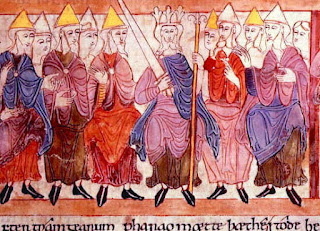After the Norman Invasion of 1066, the kings of England started to rule more as the monarchs we think of today, abandoning the English custom of a council of wise men, the witenagemot, that had aided kings for centuries. Under strong and charismatic individuals such as Henry II (who ruled from 1154 until 1189), this system may have worked, but King John was not like Henry II. He was called "Bad" King John because he taxed people so heavily. He was called "Lackland" (in Old French, Johan Sanz Terre) because he lost the Duchy of Normandy to King Philip II of France. For these and other reasons, he lost the support of his barons.
The barons decided they needed to return the kingdom's governance to a system that allowed them more input. To that end, they conferred and agreed to draw up a great charter, which was drafted by the Archbishop of Canterbury, Stephen Langton. Although Langton may not have been as affected by John's whims as the barons, he had been the cause of a dispute between John and Pope Innocent III, which had resulted in John's brief excommunication. Langton definitely saw the need to curb John's ability to get himself and England into trouble.
When John decided to tax the barons themselves in order to mount a war to regain lost provinces on the continent, the barons had had enough. The barons and Langton produced a document called the "Articles of the Barons" in January of 1215, which John rejected. The barons then armed themselves and marched to London, occupying it in May. They confronted John at Windsor Castle, and he agreed to a meeting at a place called Runnymede.
Some items established by Magna Carta:
- The Church was free to rule itself, especially in the appointment of bishops.
- No new taxes, except with the consent of the Great Council, or Parliament
- Weights and Measures were to be made uniform throughout the realm
- Everyone had the right to due process
Of course, John had no intention of being bound by the restrictions of the Magna Carta, but that's another story.



